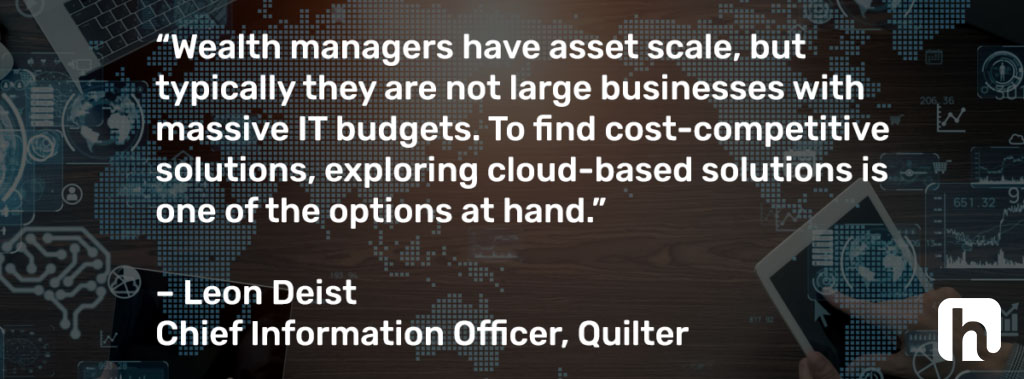The wealth management sector lags behind the rest of the financial industry in its digital transformation journey. Banks are between five and 10 years ahead, explained Gillian Painter, Head of Engine, the Investment Association’s fintech accelerator, in an interview quoted in our recently published report ‘How Cloud Services and SaaS are Accelerating Growth’.
To remain competitive and to capitalise on the increasing demand for wealth services, firms have to overcome the challenges presented by legacy IT infrastructure. If they don’t, they risk losing market share to competitors like robo-advisers that are designed to meet the needs of the growing number of digitally-native customers. However, knowing where to start is a challenge in itself. While a range of solutions have emerged to digitise back and front-office operations, firms must allocate resources to those adding value and keeping costs low.

Can wealth managers keep up with growth in demand?
Bain & Co predicts global revenues generated by the wealth management sector will surpass $500 billion by 2030. One of the driving forces behind this growth will be the emergence of new customer segments, as roughly 250 million Gen Y and Gen Zers (born between 1981 and 2012) will earn an annual salary of over $100,000 by then. Meanwhile, consultancy Oliver Wyman expects the affluent and low High Net Worth segments to experience the quickest growth in the shorter term, creating $45 billion of new revenue and accounting for 60% of total wealth management revenues by 2026.
The question wealth managers need to ask is whether they’ll be in a position to capitalise on these opportunities to drive fresh revenue streams?
Digital transformation is critical, considering customers have become accustomed to the kind of personalised experience delivered by apps such as Amazon and Uber.
While the sector has made headway, it still has work to do. In October 2022, WealthBriefing published the tenth edition of its Technology and Operations report. According to the report, nearly 70% of financial institutions believe leveraging technology reduces costs and risks. Furthermore, research by Deloitte suggests technology investments result in a productivity gain of an average of 14%. But when asked to rate progress on their digitisation journey, wealth managers only scored an average of 3.5 out of five.
So where should firms focus their investment?
Celent has identified what it considers the five core blocks required to build the next generation of wealth managers:
- Client communications and collaboration, such as live chat, virtual assistants and social media.
- Data management, leveraging AI and machine learning.
- Advice delivery, both DIY and advisor- led as well as hybrid models.
- The ‘democratization’ of wealth management, for instance allowing customers to invest in alternative asset classes like fractional shares and cryptocurrency.
- An open ecosystem model providing access to non-traditional products and services by employing application programming interfaces (APIs) and ‘as-a-service’ solutions.
Wealth managers can’t fix everything at once, so they must decide which of the building blocks listed above deliver the most value at a reasonable cost. One approach is to use a modular wealth management system.
What is a modular wealth management solution?
Modular solutions consist of a core operating system which allows firms to quickly and easily add or remove functionality. For example, Huddlestock’s investment management system offers various modules designed to enhance operations including investment portals, customer onboarding, multi-asset trading, corporate actions and compliance.

Modular solutions offer several advantages over legacy IT systems :
- Faster go-to-market- In most cases, the functionality required by a user to meet evolving customer needs, such as an ESG product or a robo-adviser, already exists on a modular solution.
- Cost-effective- A modular solution is cheaper than developing and deploying new functionality on a legacy system, which may require investment in infrastructure. Users only pay for the features they need, keeping procurement, implementation and maintenance costs to a minimum.
- Lower risk- Wealth managers can invest significant time and resources adding functionality to a legacy system, only to discover it rapidly becomes obsolete, or it isn’t fit for purpose. If a modular solution isn’t right, it can be removed.
- Improved ROI- Lower implementation and maintenance costs mean the ROI is higher for modular solutions than new functionality built on legacy technology, which typically takes years to earn back the investment.
Further benefits of modular systems include:
- They seamlessly integrate with other providers and tools via an API.
- They don’t lock users into long-term contracts or enforce restrictions in terms of scope.
- They automate front and back-office processes, so the user can scale up to meet rising demand.
- They’re automatically upgraded by the provider.
Evaluating modular wealth management solutions
Before investing in a modular solution, wealth managers should take several factors into consideration.
Integration- One of the most important is how the solution integrates with existing systems. Many connect via an API, but it’s worth checking with the provider if the API is well documented and the degree of flexibility it allows for custom integrations. If third-party support is required, it adds costs.
Costs- A modular solution may incur three layers of costs which impact ROI: implementation costs covering integration and deployment, recurring costs (a subscription) for ongoing access, and operational costs to pay for maintenance and upgrades.
Expertise of providers- Providers should have a track record of successful delivery of modular solutions in the wealth sector. The team should also demonstrate extensive experience, ideally encompassing the traditional financial and fintech sectors.
Get in touch to learn how Huddlestock has helped wealth management firms approach modular software implementation.
